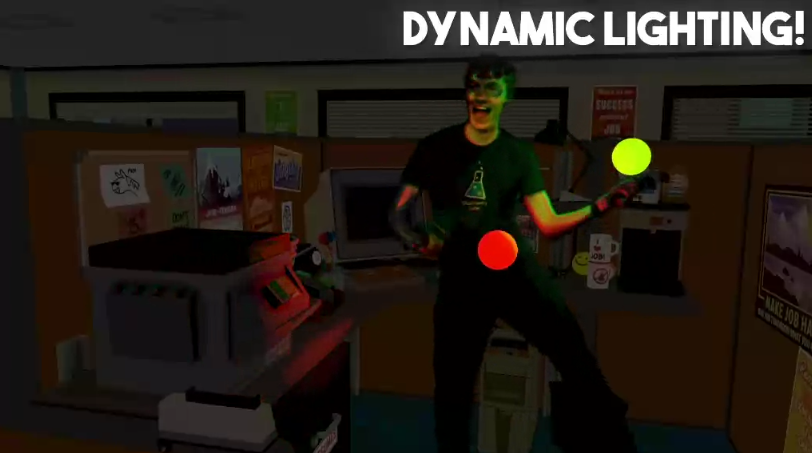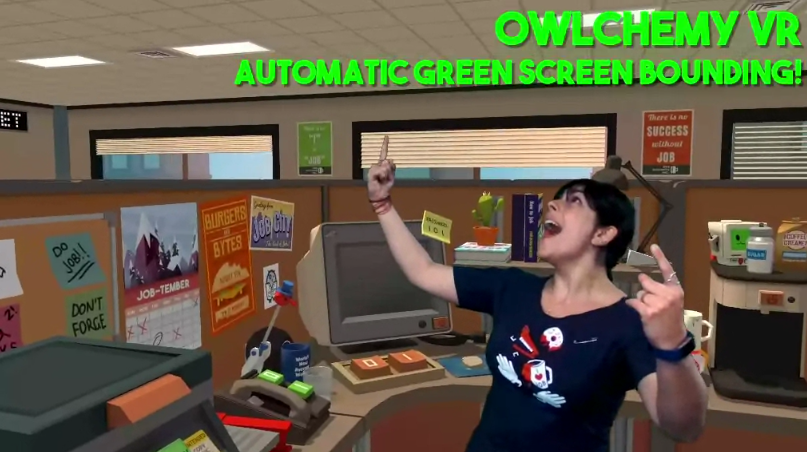Owlchemy Labs Continues To Push The Limits Of Mixed Reality
Owlchemy Labs is well known in the virtual reality industry for creating the highly regarded Job Simulator VR game. Owlchemy was the first developer to show a working Vive title to the press, and one of the first developers to dabble with mixed reality video. Now the company is pioneering in-engine tools for mixed reality recording.
In early October, Owlchemy Labs gave a sneak peak of a custom shader and plugin that it created that allows the developer to import footage captured by a depth camera directly into the Unity engine. The custom plugin allowed the developer to composite the mixed reality scene without third party software. It also allowed for proper depth compensation, as well as the ability to reach behind in-game objects.
The creative minds at Owlchemy Labs weren’t satisfied with just importing 3D video into the rendered scene, though. They spent the past six weeks adding useful and innovative features to the OwlchemyVR Mixed Reality toolkit.
Game Objects Illuminating Real People
The latest internal build of Owlchemy’s MR tools incorporates dynamic lighting that interacts with the player in the scenes. The light from the game engine illuminates the player as if they were really in the digital environment. The dynamic lighting effects also cast realistic shadows on the player's face and body.
Mixed Reality Transparency
Owlchemy Labs is finding that importing the video footage into the engine has other benefits beyond being able to reach behind objects in VR. Having the video footages blended into the game footage within the game engine allows the developer to do proper alpha blending, which in turn allows the developer to use translucent blending in real-time mixed reality. Owlchemy Labs pointed out that transparencies in mixed reality would allow for effects such as smoke, rain, or standing behind a window pane.
Smaller Green Screens, Bigger Filmed Scenes
Mixed reality VR usually requires a green screen large enough to wrap around at least one corner. If your screen is too small, it's easy to catch part of the real world in your shot. This is especially true if you’re using the third controller method that allows you film mixed reality VR with a moving camera.
Owlchemy Labs developed a tool called Green Screen Bounding, which keeps track of the position and size of your green screen and automatically compensates when your camera films beyond the green screen. Green Screen Bounding allows you to spin your camera around freely without worrying about blending the real ceiling, walls, or objects into the recording. With the Green Screen Bounding technology, you don’t have to cover an entire room with green; you can get away with a single muslin backdrop.
Get Tom's Hardware's best news and in-depth reviews, straight to your inbox.
Beta For Developers
Owlchemy Labs doesn’t intend to keep the OwlchemyVR Mixed Reality toolkit to itself. The company is eager to get its tools into the hands of other developers and content creators. To that end, the developer is accepting applications from interested parties for access to a private beta of the toolkit.
Kevin Carbotte is a contributing writer for Tom's Hardware who primarily covers VR and AR hardware. He has been writing for us for more than four years.
-
wifiburger mixed reality hen ? what a perfect example, job simulator ! we've gone from full games to casual games played on the phone not even qualifying as games and now we're back to the PC with an even more obscure category beyond casual ! no thanksReply




